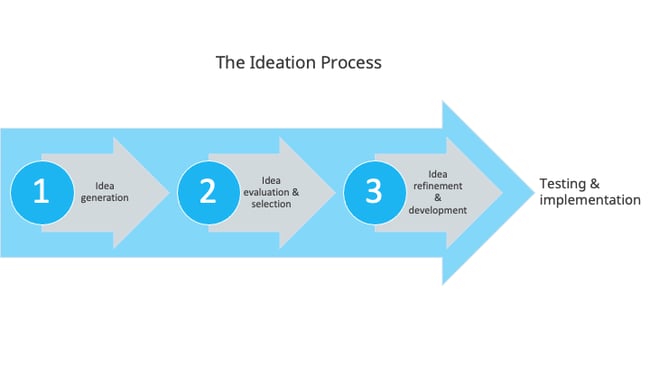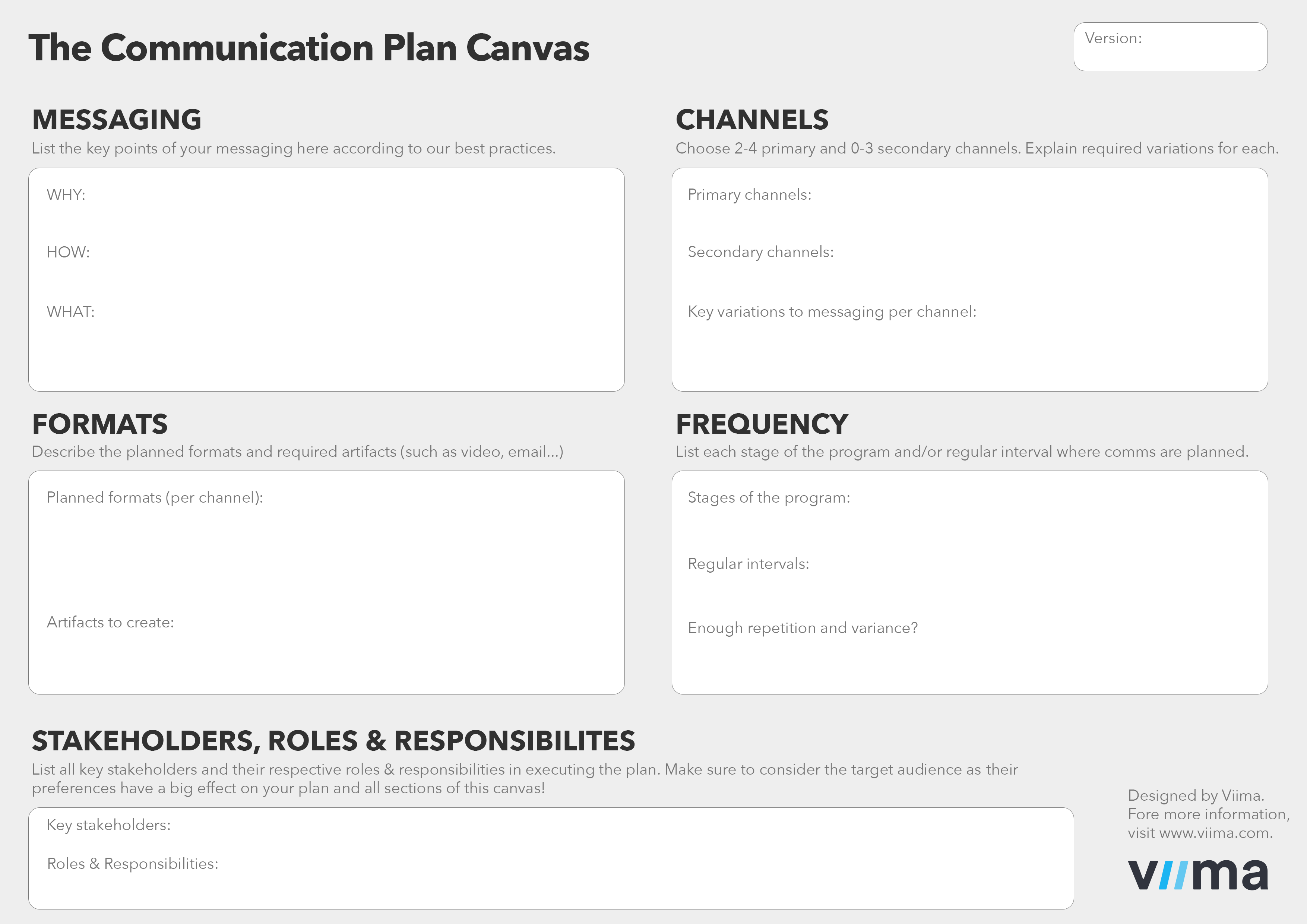Turning Ideas into Innovations: An In-depth Guide
Every innovation starts with an idea. We all have ideas, even great ones, yet few people can bring them to life, and even fewer can turn them into innovations.
The topic of how to turn ideas into innovations has sparked many conversations and filled the internet and libraries with potential solutions. However, we realized that many online articles on this topic barely scratch the surface or don’t dig deep enough to explore the ins and outs of turning ideas into innovations.
The reason behind this is understandable. Bringing ideas to life is not easy and there is no silver bullet that can miraculously work for everyone everywhere. To add to the difficulty of implementation, ideas come in all shapes and forms, some more daring than others, which makes it even more difficult to come up with a practical roadmap.
However, as part of our mission to help customers turn more ideas into innovation, we want to give you the tools and information that can help you create your own roadmap for converting more ideas into reality.
We wrote extensively about innovation, ideation, and how to best manage ideas, but we haven’t covered this comprehensive topic in much detail. And to be honest, we can’t promise to provide all solutions and answers, but we are ambitious enough to try and provide as much value as possible, and hopefully inspire you to pursue your ideas and take them to completion. So, without further ado, let’s get to it!

Table of contents
Why aren’t more ideas turning into innovations?
When talking about ideas and how to turn them into innovations, we can consider two viewpoints:
- the path an idea takes towards implementation, and
- the environment in which that idea is developed.
Coming up with an idea can happen suddenly, it can be a spark, a moment of inspiration we have when least expected. But the path to implementation is often challenging and takes time, even if its completion is independent of external forces.
Scaling ideas at an organizational level is even more complicated. The structures and processes in place can make change and innovation at scale a lot more difficult. Developing ideas in a company could take weeks and implementing them could even take years of hard work and excellent execution from teams of experts.
To this, we add the things that are less obvious at first glance, but that can prevent people from working on new ideas.
For example, people with a growth mindset will be more open to working on new ideas or trying new things. Studies show that a growth mindset contributes to innovation and that in the right environment where continuous learning and improvement are promoted, people can develop new skills and be influenced into developing a growth mindset.
So, if leadership is not promoting such behavior, and is not focused on hiring the right people, bringing novel ideas to life becomes almost mission impossible.
There are also the biases that prevent us from recognizing ideas with potential. There’s a common misconception that to innovate, you need innovative ideas, those ideas that would lead to disruptive or radical innovations. That’s a sure way of missing out on opportunities that could add value to the bigger picture.
Recognizing great ideas is challenging because there’s no textbook on how to see the potential in disruptive or less obvious ideas. Kodak and Xerox fell in this trap, maybe blinded by short-term wins, they missed the opportunity of being the first to bring to the market the digital camera, and the personal computer.
While they were pioneers with these innovations, they missed the chance of turning them into successful, widely embraced products. Of course, it’s always easier to go for the most obvious and easy to measure ideas and implement the low-hanging fruits.
Leaders play a part because they should be able to acknowledge that anyone can have great ideas. But even with an open mind, they still need the capabilities, methods, and tools to support such work. It’s difficult to systematically listen to frontline workers and their ideas without a process in place that enables people to contribute and share their knowledge.
Innovation management processes play a big role in transforming potential ideas in value-creating innovations. Many organizations lack a process that helps them to systematically generate, prioritize, evaluate and validate ideas. Some are stuck in the traditional hierarchies where top management makes all decisions, sometimes without insights from the “bottom”. Of course, the field in which you operate plays its part, and some areas like medical innovation, could still benefit from a more traditional approach.
In short, these are things that can be fixed at a higher level. In practice, you can have all the best processes but if you lack the capabilities, you are likely to fail. Whether it’s the tools to manage innovation, the budget, support, and skilled employees, these are all essential things you’ll need if you want to see more ideas shape up.
Having seen the bigger picture and what makes idea implementation so difficult, it’s now time to go through some specific roadblocks and how to overcome them.
Common innovation roadblocks and how to overcome them
As we always say, if you are innovating you are creating something new which consequently means that others haven’t done it before, so mistakes and failure are normal and expected. Even though there’s no secret that failure is part of the process, some leaders have trouble understanding the extent of this failure or are simply afraid to jump head-first because they expect certainty before making any investment decisions.
The only sure thing about innovation is that there’s almost always something that either goes wrong or blocks the process.
Unfortunately, the only sure thing about innovation is that there’s almost always something that either goes wrong or blocks the process (if you have one in place). We can’t predict the future, but we can talk from our experience that there are certain roadblocks that are more common than others and once you start noticing those, you can work on removing them.
-
Too much focus on ideation
We are in the idea management software business so it might come as a surprise when we talk about ideation being an issue. This is what we try to address by designing and developing our software and what we emphasize in our discussions with our customers.
As mentioned, organizations don’t lack ideas, but rather a structured way of managing them. Unfortunately, many organizations waste a lot of time with brainstorming sessions that on the long term don’t add to much.
The problem with this approach, especially when done sporadically, is that organizations end up having many ideas, sometimes the same ones repeatedly, but they don’t know what to do with them. Best case scenario, they pick the low hanging fruits and work on those. But on the long run, they might not lead to ideal innovation outcomes.
There is a time and place for such events, but they should be aligned with the strategy of the company and tied to specific goals. What’s often lacking in such events are the skilled people to take ownership for the ideas.
As we previously emphasized, ideation shouldn't be just about generating ideas. Ideation is a whole process that leads to implementation and whether you’re ideating for continuous improvement or radical ideas, evaluating, selecting, refining, and developing these ideas should also be part of the process. If you’re ideating for the sake of having new ideas, you’re probably performing on the innovation theater stage. Which takes us to the next point on the list.

-
Innovation theater
Focusing too much on ideation is just one of the culprits that contributes to innovation theater, which we discussed in detail here. Other contributing factors could be too much focus on cool technologies, fancy offices and fun environments, or the disregard for business strategy, the lack of resources for implementation and so on.
In short, this focus on what appears to be innovative and copying what other innovators seem to be doing, disregards the hard work required for real results.
Throughout his career, Steve Blank has observed this phenomenon up close, and noticed how typical innovation activities like hackathons, innovation workshops or design thinking classes are adopted by companies with little success. While such activities can nurture a more innovative culture, and can engage employees on the short term, on the long term the results will fail to show up.
To overcome this, take a closer look at those idea on the whiteboard. Are they really bringing value, could they be tested, do they solve a problem and perform a “job” for customers? And most importantly, how will you actually implement that idea? Once you find a good fit, stay focused on scaling that solution to drive value for everyone involved.
-
Lack of common language
Another often overlooked aspect is finding the common language and landing on the same page with everyone concerned.
As Curtis Carlson points out in his Innovation for Impact framework, there should be a consensus of what innovation and value means for your organization. Surprisingly, it’s very common that there’s no shared language for important concepts of innovation and it can become a major roadblock when trying to identify the ideas that are indeed worth pursuing.
Clearly communicating the strategy, the values and what the organization stands for will help clarify the most common terms and what they represent for the company’s future.
As we pointed out in our previous article on how to communicate an innovation program, every organization is different and communication should be adapted accordingly. Sometimes it even makes sense to just talk about improvements instead of innovations if that makes is easier to have everyone on the same page. Our advice is to create a communication plan that you first test on a smaller audience.
Briefly, you’ll have to consider:
- The messaging. Start with the “why” to get people on board and help them understand the reasons behind your actions. Then add the “how” and “what” which put things into perspective and clarify what is required from everyone and how things will move forward in practice.
- Next, are the channels which can look very different from one organization to the next. You might want to adapt your content for different channels. Long-form emails will help you explain in more detail the steps and actions required. Instant messages are best for short updates and checkups with the team. Ideally you don’t use more than 5 communication channels, keeping it simple with 2-3 primary ones.
- Then we have the formats, deciding when is best to use face to face meetings, texts, video or visual communication.
- And lastly, the frequency with which everything is communicated. You need to strike the right balance which will help engage people and keep them motivated without irritating them with an overflow of information.
To dig deeper on how to best communicate these plans you can download our Communication Toolkit, where you can also find the Communication Plan Canvas.

-
Lack of innovation talent
Large companies often know their industry and customers well and have plenty of resources, but they don’t necessarily know how to lead innovation, nor have the talent to make that happen and scale it. These are all often very different from how the company is used to doing things.
Recruiting the best people is now a competitive advantage for successful organizations. As we previously talked about the value of knowledge, especially tacit knowledge, that’s what you want to harness to make more innovation possible. At the same time, it’s one of those things that can make or break the success of a company. If you don’t have the talent, skills, and knowledge, you are missing essential capabilities to move things in the right direction.
Tim Woods wrote an insightful summary on how Google manages to hire the best people and keep their culture of innovation alive and thriving. Their innovation methods are well known nowadays and serve as inspiration for many.
However, their style might not be for everyone and as always, we emphasize the importance of adapting practices and methods to your own environment instead of copying what worked for others. The culture of a company should be yours, and yours alone, not a copycat.
From idea to innovation
Ideas are not innovations and having an idea doesn’t automatically make you an innovator. At the same time, groundbreaking ideas aren’t the only ones that can make innovation happen, as often even a few simple ideas can add up to great results. Discipline, patience, and commitment to a process of continuous learning, testing, development, and iteration are essential.
Of course, all these take time, but you need to start somewhere. So, let’s see some practical steps that will help you get started.
1. Figure out what customers need
Many successful products and services come from companies that understood very well the underlying needs of customers. To connect with your customers at a deeper level and uncover desires and aspiration, you can put to work the Jobs To Be Done theory.
The Ten Types of Innovation Framework is one of the tools you can use to understand and rethink your market and identify further opportunities for innovation. It can help you assess your services, product or market and observe what works well and where you have room for improvement and innovation.
Once you have this information you can device new ways to bring value in the areas that interest you most.
%20.png?width=1686&name=Ten%20types%20of%20innovations%20(1)%20.png)
But before that you want to know if you are on the right track by validating your assumptions.
2. Validate the most critical assumptions first
Validate your biggest and riskiest assumptions first through small tests before scaling them. If you go the other way around and first create a solution you think might be solving a problem, you’re on the wrong track. That’s why the first step of uncovering the jobs to be done is so important.
Often the assumptions are different from the actual challenge, so you want to keep the validation process simple and focused on the most important aspects of the business.
If you want to learn more about the steps and tool for validating an idea, we wrote a guide on this topic which you can download for free.
3. Create customer value
What is valuable for you might be irrelevant for others. By uncovering the jobs customers need done you will identify new ways to create value. And if you believe an idea to have the potential to add value, test that assumption. Is it adding value to the company alone or to customers too?
The Blue Ocean Strategy is another useful framework in this context and it’s based on the idea that you can create new demand and conquer new markets by creating value. In short, this framework describes how to simultaneously pursuit differentiation and low cost to create value innovation.
4. Analyze and iterate
The focus here should be on iterating based on information you gather from customer behavior, rather than from surveys or focus groups.
Why is this difference important? Because as the Jobs to be Done theory shows us, customers don’t always know how to express their needs or why they landed on a product or a service in the first place. Their behavior can reveal things you might have not considered at first so it’s essential to iterate if you want to refine and develop your idea.
Iteration is after all the cornerstone of continuous improvement, and that’s the key to innovation for some of the most successful companies.
5. Quick cycle times
Increasing the cycle times helps increase the pace of innovation and therefore speeds the improvement or introduction of products and services. The classic examples here are SpaceX and Amazon. For instance, SpaceX is said to have the ability to push software into production 17 000 times a day.
Naturally, not everyone has the capabilities of SpaceX, which sounds more like the exception rather than the rule. You don’t have to compare your capabilities with giants like Amazon or SpaceX, but you can still increase the speed through small improvements and a few good practices.
These three practical tips are useful for most ideation work and can help you identify weak spots and whether the ideas you work on are bad, or if they just got stuck because of poor communication, slow testing and validation, or if other bottlenecks are in the way.
How could your organization turn more ideas into innovations?
Now, let’s zoom out and look at some big picture best practices that constitute the building blocks of good innovation practices.
1. Innovation strategy
So, to turn ideas into reality we have to step back and consider the crucial role of an overall strategy, which defines the contribution of innovation within the organization. We wrote extensively on the topic of innovation strategy, the starting point to turn ideas into innovations, as well as the mistakes to avoid.
Before asking yourself why your ideas aren’t coming to life or why isn’t the organization innovating more, consider the strategy and check for the capabilities required to move things forward. If you want your ideas to turn into innovations, you need an innovation strategy that stirs you in the right direction and delimits the market and technology where innovation is needed.
So, an innovation strategy is simply just a set of decisions on how to fulfil the company’s strategic goals related to achieving something new or improving on something
Without a strategy to guide you, it’s easy to end up in a situation where you either:
- spend a lot of time and money implementing all kinds of innovations, only to find out that they aren’t really that useful for your business.
- have a hard time finding quality ideas and innovation projects that could meet your funding criteria in the first place
2. Managing the fuzzy front-end
The early stages of any innovation process are often covered in ambiguity and uncertainty.
The innovation strategy is the first attempt for a more structured, unified and clear image on what’s to come. Still, you can’t foresee the future so to some extent you need to be prepared for some uncertainty.
That’s what we call the fuzzy front-end of innovation. At this stage you might have identified opportunities and ideas to leverage them, but there’s still a lot of uncertainty around managing them.

Because every organization deals with different processes, ideas and challenges, the fuzzy front-end can look very different in each case. To mitigate these uncertainties and bring a bit of clarity to the process, create different processes to help you manage ideas more efficiently. These processes should be explicit, clearly communicated throughout the organization and decision-makers should be accountable and follow specific performance measures.
While some ideas are no-brainers to implement, most ideas with big potential for innovation come with plenty of unanswered questions as well as strengths and weaknesses. That’s why it’s very important to evaluate and validate them through tests on a small scale.
The key to getting this part right is to make sure you are not trying to force every idea through the same process. If you have just one process and innovation committee deciding on all the ideas, decisions will be slow and sub-optimal. This centralized approach to decision-making can easily turn into a bottleneck.
For example, a dedicated R&D or innovation team might have no clue if a marketing idea has potential, but your best marketers probably would.
3. Getting implementation right
Staying close to your customer is key to understanding their needs. Yet organizations still miss this connection when they want to innovate. Statistically, you won’t get it right the first time and as we’re about to see, most successful businesses are the result of hundreds or even thousands of iterations.
One such example is James Dyson who had more than 5 000 attempts and it took him 15 years to reach success with its vacuums and later on expand to a new line of products.
Another, more famous example is Edison, and his thousands attempts to create a feasible lightbulb. Then if we think of a less conventional example, Picasso made at least 20 000 works of art in his lifetime, but few are famous and highly valued. Even Einstein published 240 papers, yet he had a short number of successful works.
These examples, and many more prove not only that persistence and resilience are key elements, but that innovation requires a lot of work, plenty of failures and also big volume.
Get the right team together and allow them the freedom to operate and explore.
As mentioned in the previous section, innovation requires a different mindset and not everyone in your team might be ready for that. So, get the right team together and allow them the freedom to operate and explore. As Dyson explains, it’s important to bring together not just the most experienced employees, but also the curious minds.
Last but not least, have a combination of patience, discipline and commitment to the process, while also remaining ruthlessly critical about what you know, and what your current shortcomings are so that you know how to improve and where to go next.
Conclusion
To summarize, if organizations fail to innovate it’s almost never because they’re short on ideas, but because turning individual ideas into innovation isn’t easy. However, with the right approach, you can dramatically improve your odds of success.
Remember that ideas need a solid WHY to be aligned with the strategy. Do you have ideas that would innovate outside the core, or ideas that can improve products, services or process and add up on the long term to incremental innovation? These are all questions you’ll need to reflect on.
If you want to filter through the many ideas you have at hand, you’ll need an evaluation process in place to test your assumptions. Also, consider the timing, as some ideas might take longer to catch on. At the same time, you don’t want to be too late to the party.
The classic example here is the case of Netflix taking over Blockbuster. Of course, there’s a combination of elements that led to Blockbuster failing into oblivion and Netflix becoming the number one streaming platform, but the results speak for themselves. You don’t want to miss the train to innovate.
As already mentioned, all these efforts require a different mindset, a dedication to innovation processes and openness to see the potential in novel ideas that might not seem so innovative at a first glance. And if you approach this systematically across the organization you can make a big difference overall.
This article might not provide all the answers, but getting from idea to innovations is after all a learning process in itself. If you want to learn more about idea and innovation management, our Innovation System online coaching program is now completely free of charge for the first 1000 readers to sign up for it.










